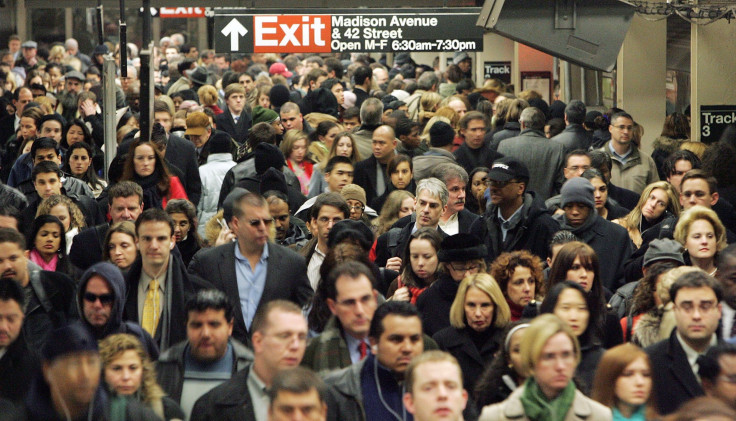World Population Day 2017: Why There Are More Men Than Women

World Population Day is observed on July 11 every year, when it’s time to turn one’s attention to the pressing issues of alarming rise in population, awareness about family planning, gender equality and women empowerment.
According to United Nations, there are 7.4 billion people occupying the earth at the moment and going by the rapid expansion of population at the moment, it would cross 8 billion by the end of 2023. At least six countries will double their population by 2050, according to USA Today. However, even then, chances are the number of men would be greater than women, a trend that has remained unchanged since ancient times.
While the gap between the number of men and women has closed considerably in the last couple of years, it is something that has not occurred uniformly across the world. In 2011, 107 male children were born on an average for every 100 female births, Live Science reported. Just four years down the line, the same equation came down to 101.8 men to 100 women, Business Insider reported.

However, there are still countries in the Middle East such as United Arab Emirates where the ratio remained 274 men for every 100 women. Areas like Northern America, China and India also tend to have higher men to women ratio. India has 48 million more men than women while China’s men population tops that of women by 42 million, according to Quartz. Some consistent factors have influenced the men and women ratio in the long run.
It is no secret that developing countries like India and China prefer a boy child to a girl child and hence tend to practice sex-selective abortion and "gendercide," a term that means the mass genocide of a particular gender (in this case, female). However, both the countries have taken important steps in curbing the illegal practice. While India legally banned sex determination before birth in 1994, China eased-up on its one-child policy, which was one of the main reasons for gendercide.
Another factor that could lead to there being more men than women in the world is because there is a notion that women tend to give birth to male children more than female children. In a 2015 study done by Proceedings of the National Academy of Sciences, which took into account 140,000 embryos and 900,000 samples across the United States and Canada, it was seen that the rate of male and female child conceived by women were more or less equal.
However, the number of male newborns that saw the light of the day was greater than female ones, which might be due to the high mortality rate of the latter in the mother’s womb. The study beat the earlier notion that male embryos face higher complications during birth.
One of the natural aspects that might work in favor of women and hence aid gender ratio to normalize significantly is the fact that women have a higher life expectancy beyond the age of 60. The average life expectancy for women is 71.1 years while for men its 67 years, Science ABC reported.
This might be the reason the gender ratio in Russia is 86.8 men per 100 women, which is closely followed by Latvia (84.8), Ukraine (86.3), Armenia (86.5), and Belarus (86.8), according to Pew Research. Other than the fact that World War II led to a sharp decline of young-spirited, able-bodied men in Russia, alcoholism also seems to have contributed largely to the lopsided gender ratio in the country. Vodka remains one of the major reasons of homicides and suicides in the USSR with 52 percent of the women viewing alcohol consumption as morally unacceptable, compared with just 36 percent of men.
Organizations such as Ministry of Women and Child Development (India), Europe Aid, Family Planning 2020, She Decides and the United States Population Fund have issued awareness on the importance of family planning on the occasion of World Population Day.
Let’s educate on safe family planning methods and foster a better future. #WorldPopulationDay pic.twitter.com/EF7gZiaUqd
— Ministry of WCD (@MinistryWCD) July 11, 2017
.@gatesfoundation announces add'l $375 mil for #familyplanning: "These women are counting on us & the world is counting on them" #HerFuture
— FP2030 (@FP2030Global) July 11, 2017
Education about #FamilyPlanning is key - young people need access to info without judgement. @UNFPA @FP2020Global #HerFuture #SheDecides
— SheDecides (@SheDecidesGFI) July 11, 2017
It is #WorldPopulationDay! 214 million women in developing countries want to avoid pregnancy ➡️ #FamilyPlanning is a human right. pic.twitter.com/zQEWpcr5EY
— EU International Partnerships 🇪🇺 (@EU_Partnerships) July 11, 2017
Numbers don't lie! Get the REAL facts about #familyplanning and how it can help a woman protect #HerFuture: https://t.co/idsTJlZUkq pic.twitter.com/Kv4clPt1dp
— UNFPA (@UNFPA) July 10, 2017
© Copyright IBTimes 2024. All rights reserved.






















